Alsace Clarity
Posted on November 12, 2025

From Rivalry to Revelry
By Panos Kakaviatos for Wine Chronicles
12 November 2025
It was a night to remember in Colmar! 🌟
The 6th annual post-harvest dinner – known as Widderkumme – gathered representatives from 19 top Alsace wineries, see above photo — each devoted to expressing the soul of their terroirs, from crystalline Riesling and textured Pinot Gris to ever-improving Pinot Noir and exuberant, spicy Gewürztraminer.
Some 200 guests attended, traveling from across the globe — including acclaimed wine critic and award-winning author Ian D’Agata, who is based in Shanghai. I met podcasters and discerning private buyers, all united to celebrate Alsace’s unique mosaic of soils and styles.
As the excellent Alsace Wine Council website explains: Alsace geology is a like a mosaic, from granite to limestone along with clay, shale, and sandstone. Occupying a surface area of about 15500 hectares, this large patchwork of terroirs is absolutely ideal for numerous grape varieties to happily flourish. The terroir imprint bestows extra character and soul to Alsace wines, which are both unique and complex.
The illustration below, from the website, outlines no less than 13 different types of soils. They include mountainside soils of (1) granite and gneiss located on the Vosges mountain sides, (2) shale, a flaky rock made from the compression of clay within the lithosphere, (3) volcanic-sedimentary terroirs based on lava and ashes which became solid under water and (4) sandstone. Along the sub-Vosges hills, soils include (5) calcareous terroirs: sea-based limestone from the Mesozoic period, (6) marl-calcareous, thick clay deposits (marl) and calcareous pebbles, (7) marl-sandstone, (8) marl-limestone-sandstone, (9) calcareous-sandstone terroirs and (10) clay-marl terroirs. On the plain, soils include (11) colluvial and piedmont plain, (12) alluvial and (13) loess and loam – each of these types directly affecting the taste of the wines (along with the winemaking methods, of course!). I highly recommend readers to take a look at this page for more details.
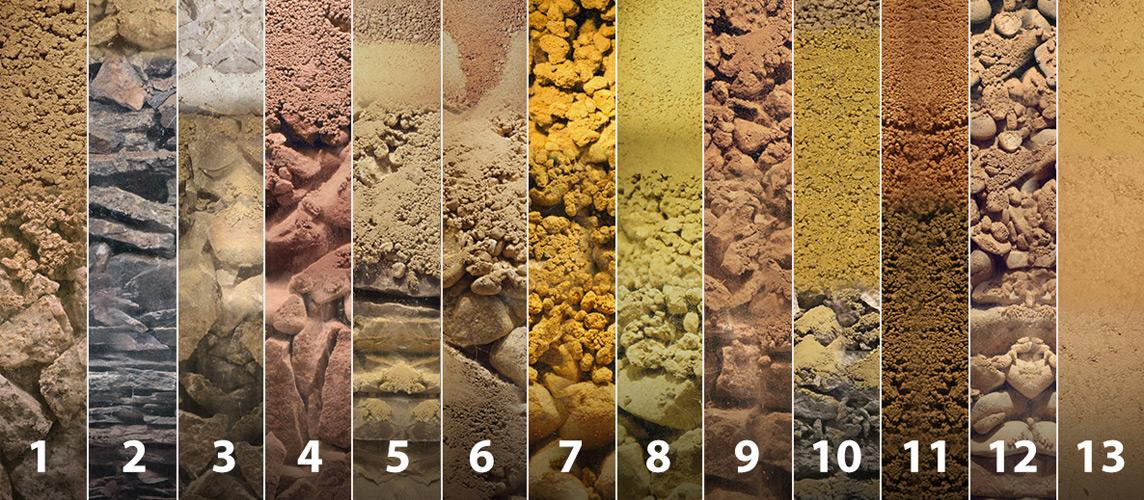
Wonderful setting, thanks to Alsace Crus et Terroirs
The tasting and dinner was held in the magnificent Salle des Catharinettes, where a life-size Statue of Liberty greeted guests at the entrance. Special note: Frédéric Auguste Bartholdi, born in the Alsatian wine capital Colmar on 2 August 1834 is best known for designing Liberty Enlightening the World, commonly known as the Statue of Liberty, which is located in New York.
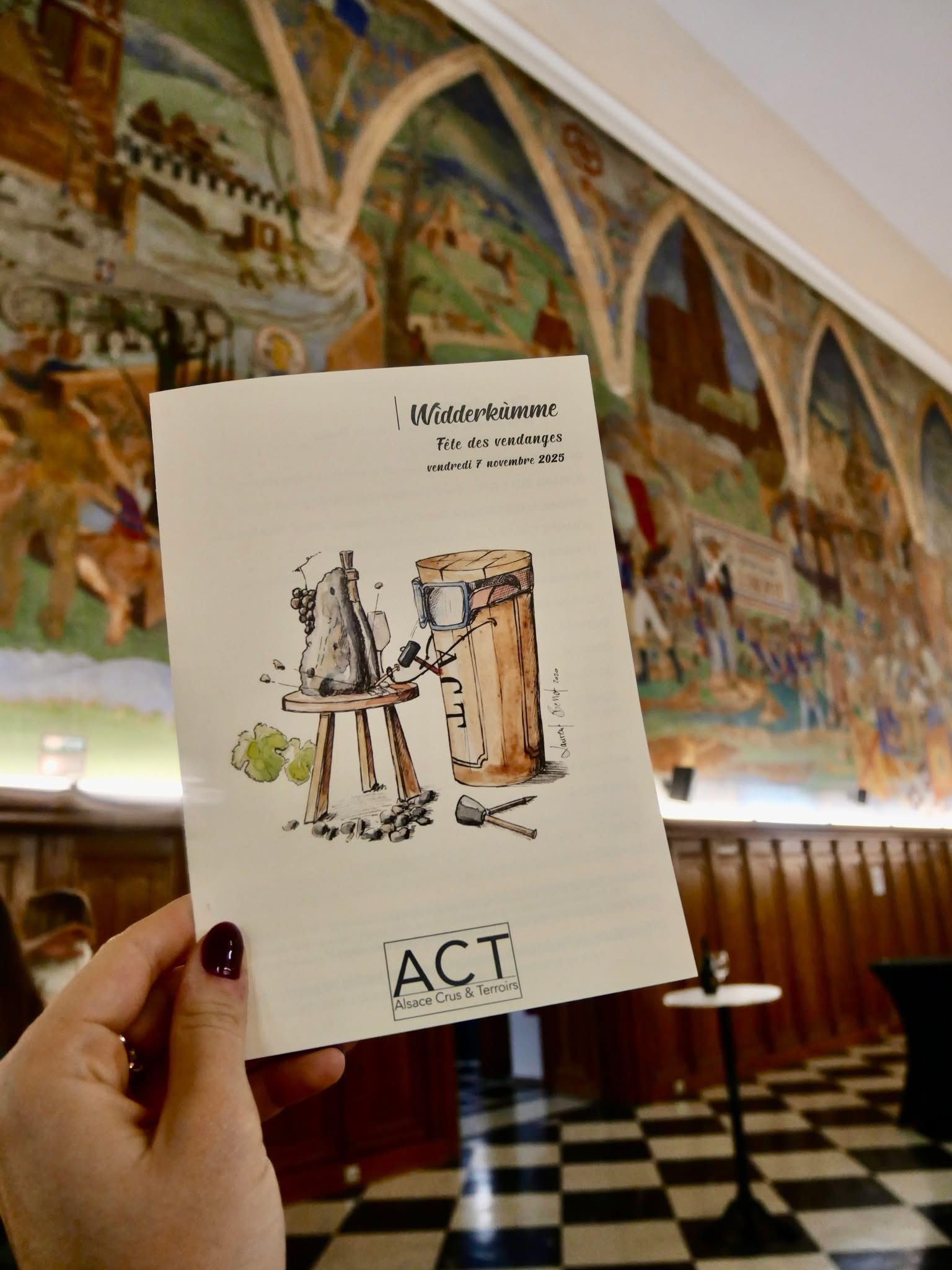
The evening began with tastings at 6 p.m., shimmering under vaulted arches, before the curtains lifted for a seated dinner with live music. 🎶
The group of 19 wineries make up Alsace Crus et Terroirs (ACT) – modelled somewhat after the German private grouping VDP. They organise tastings across France and in major cities in worldwide markets to better explain what Alsatian wine is.
A daunting task!
Are Alsace Rieslings sweet? Not at all. Please take a look at the video below with Ian D’Agata. Indeed, starting with the 2021 vintage, non-late harvest Alsace Riesling must be “dry”, as defined by EU regulations, according to a decree agreed by a two-thirds majority of the Alsace Winegrowers’ Association (AVA). The move comes in addition to the introduction of a standardized way of communicating sweetness levels on Alsace AOC still wines. Most back labels indicate specific dryness levels. I would think that an even better step would be to indicate dry on the front label, but readers should know that Alsace Riesling is dry, unless a late harvest style. As per EU rules, a dry wine can contain a maximum of four grams per litre (g/l) of residual sugar, but the limit rises to 9g/l if total acidity – measured in g/l of tartaric acid – is not less than 2g/l lower than the sugar content.
Are Alsace wines German? No. Even though many categorize Alsatian wines with Austrian and German, they are neither German (nor Austrian). And yet one winemaker told me he has an easier time selling his Riesling in Tokyo than in Paris, as many French associate Alsace with all things Germanic. Sure, the grape Riesling is German, and the names of most terroirs sound German, from Altenberg de Bergbieten to Schlossberg. In addition to the German sounding names, Alsace wine bottles resemble German shaped bottles, as opposed to the Bordeaux or Burgundy shaped bottles that dominate most other French regions, from the Loire to the Rhone. They are longer – and somewhat harder to store in wine fridges, but I digress. But Alsace is in France.
Revel in the richness
And ACT revels in this richness to prove the point that Alsace is also unique. When it was part of the German Empire (1871 to 1918), “my grandfather told me that Alsace wines always tasted richer than wines crafted on the other side of the Rhine,” remarked Alexandre Schoffit of the eponymous domain near Colmar. The geography of Alsace’s wine growing area is determined by two main factors: the Vosges mountains to the west and the Rhine river to the east. The vineyards are concentrated in a narrow strip, running in a roughly north–south direction, on the lower eastern slopes of the Vosges, at altitudes of 175–420 metres (574–1,378 ft). Those altitudes provide a good balance between temperature, drainage and sun exposure under Alsace’s growing conditions. Because of predominantly westerly winds, the Vosges mountains tend to shelter Alsace from rain and maritime influence, and the region is therefore quite dry and sunny. And I adored the superlative Domaine Schoffit Grand Cru Rangen Clos Saint-Théobald Riesling 2023, a very smooth yet lively expression of Riesling, and even if young, it was already drinking well (95/100).

Marion and Alexandre Schoffit of the eponymous estate.
Another aspect of Alsace has been intense competition among winemakers to gain limited market share, but – finally – ACT has come together with the philosophy of force in unity. As one winemaker confided to me: “Our parents would never have done this,” evoking the days when rivalry ran like a cold wind through Alsace’s vineyards — a Game-of-Thrones chapter now closed. Today, collaboration and pride define this complex, beautiful, and still misunderstood region. ✨🍷
I cannot recommend enough the great wines of Alsace. Below, some tasting notes highlights from the evening:
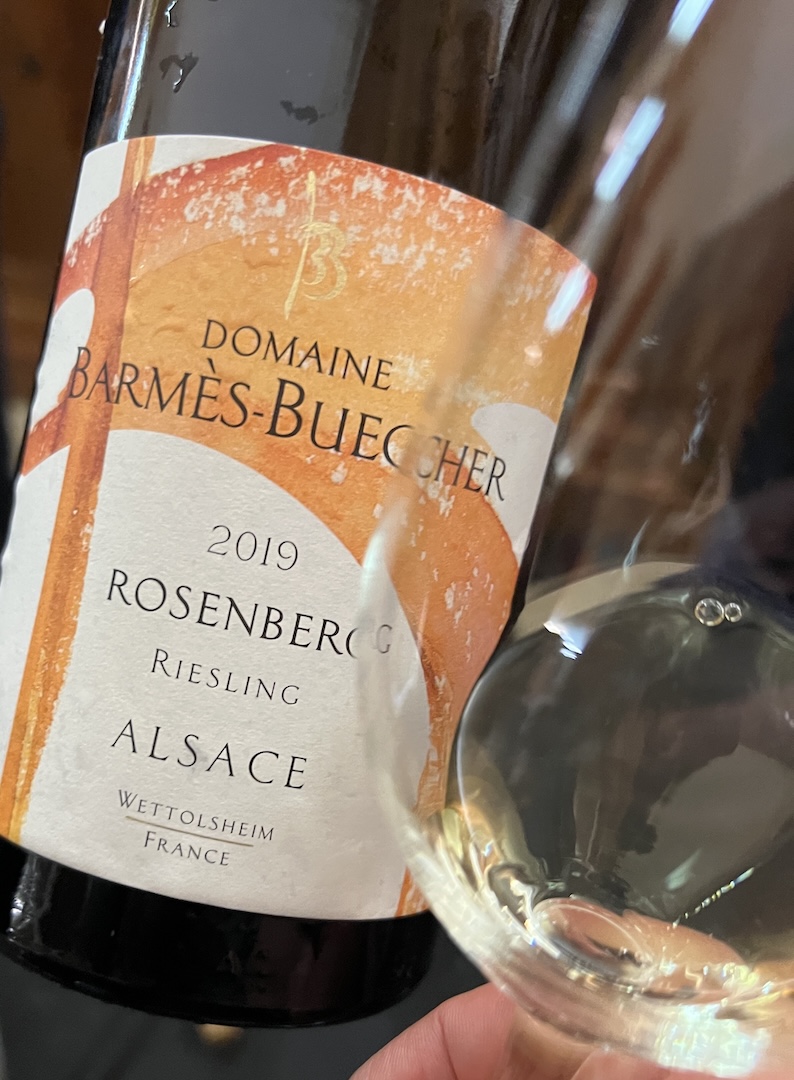
No need to be a Grand Cru to be grand.
Domaine Barmès-Buecher Rosenberg Riesling 2019 – From a magnum, intense and powerful, with an almost tannic feel to its full body white, very special! Rosenberg means “mountain of roses,” with soils of clay-limestone and sandstone: an emblematic terroir of the Barmès Buecher estate, and the Riesling mirrors the potential of this terroir, with citrus and crisp fruit. Not even a grand cru, but a superb lieu dit, the wine displays a palate of power along with salinity and depth, leading to a magnificent, long finish of citrus with touches of passion fruit. A wine that is complete, spherical. Aged 11 months in vats and large oak barrels, fermentation with indigenous yeasts. The 19-hectares estate (rather large for Alsace) has been organic and biodynamic for some 15 years already. I kept returning to this wine as a bookmark, proving that 2019 is an excellent Alsace vintage. (96/100)
Domaine Kirrenbourg Grand Cru Brand Riesling 2020 – Also from magnum, this wine has plenty of depth and breadth, and could be compared to a fine Meursault, even if it is Riesling. The Brand Grand Cru has granite soils facing south/southeast, known for obtaining optimal ripeness and evincing minerality. While the wine is more intense than the Rosenberg, with plenty of juiciness and mid-palate sap, you get a touch of heat and hint of sweetness that was not in the preceding wine, which I prefer. (94/100)
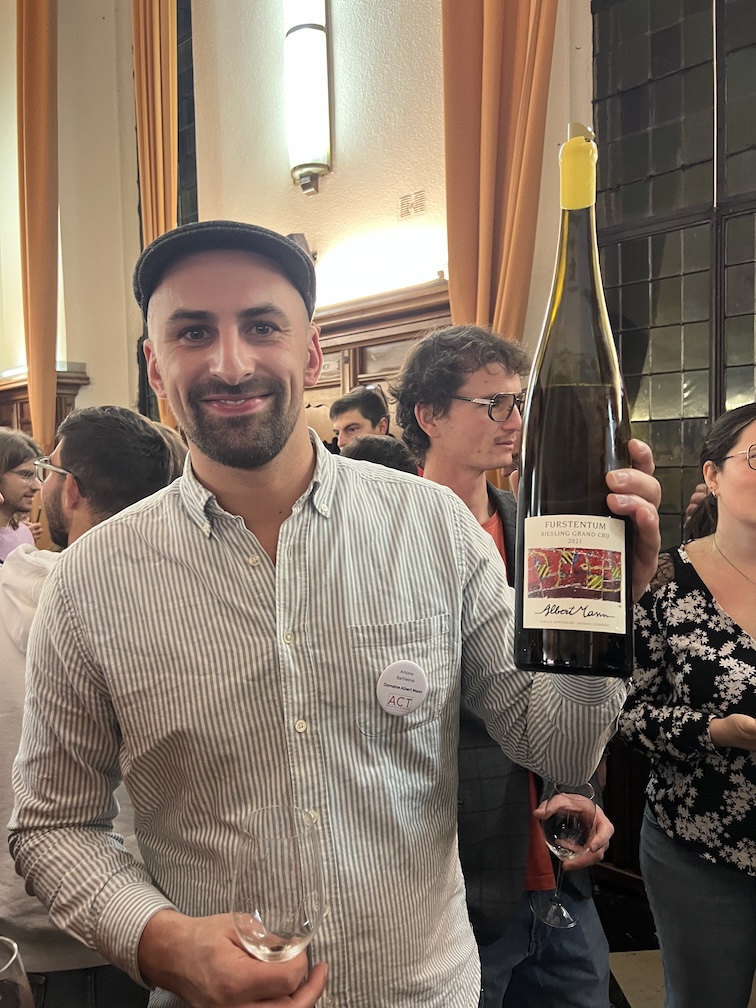
Domaine Albert Mann Furstentum Grand Cru Riesling 2021 – Served from yet another magnum, by co-owner Antoine Barthelmé, at left. With a brisk attack, this wine evokes power, coolness and plenty of citrus including grapefruit and lime. The vintage was cool, the wine thus reflecting more precision and linearity than breadth, but with harmony and refinement: one of my favorites tasted over the evening. The Furstentum Grand Cru includes limestone soil, which often results in chiselled wines like this one and bright aromatic expression. Long finish. Thoroughly dry and exciting! (96/100)
Valentin Zusslin Grand Cru Pfingstberg Riesling 2019 – I do not know this estate as well, but yet more proof that 2019 is a great vintage: Bracing acidity, juiciness, subtle wet stone (not petrol), brisk even if not as long as the Albert Mann Riesling. At a high elevation of between 270 and 370 meters, the soils of the Pfingstberg are marl-limestone and sandstone. (95/100)
Domaine Zind-Humbrecht Clos Jebsal Pinot Gris 2020 – Some participants picked this Pinot Gris as the wine of the evening, and I would see why. For many years this wine reflected botrytis in the grapes, but – as the estate explains: the development of noble rot in a warmer climate is not conducive to preserving acidity and, above all, botrytis takes on a completely different aspect, much less noble. In 2020, a very early year, the domain decided to harvest grapes before botrytis developed. So 2020 is the driest Jebsal in domain history: a style is set to last. And a style I love. Robust, packed with juicy fruit, seamlessly round yet textured on the palate leading to a long finish. You have to taste it to understand it. It would go very nicely with seared scallops in a cream sauce. About the location: Clos Jebsal is located just below the Grand Cru Brand, separated by a geological fault that delineates the primary granite of Brand and the gypsum marl of Keuper on Jebsal. It is a small 1.3-hectare Clos that was rebuilt by Léonard Humbrecht in the 1970s, then replanted with Pinot Gris in 1983. Facing south on a very steep slope, the grapes ripen quickly. The marl soil is deep and cold at the bottom of the Clos and on the terraces, while limestone is more prominent in the upper part. Bravo! (96/100)
wine reflected botrytis in the grapes, but – as the estate explains: the development of noble rot in a warmer climate is not conducive to preserving acidity and, above all, botrytis takes on a completely different aspect, much less noble. In 2020, a very early year, the domain decided to harvest grapes before botrytis developed. So 2020 is the driest Jebsal in domain history: a style is set to last. And a style I love. Robust, packed with juicy fruit, seamlessly round yet textured on the palate leading to a long finish. You have to taste it to understand it. It would go very nicely with seared scallops in a cream sauce. About the location: Clos Jebsal is located just below the Grand Cru Brand, separated by a geological fault that delineates the primary granite of Brand and the gypsum marl of Keuper on Jebsal. It is a small 1.3-hectare Clos that was rebuilt by Léonard Humbrecht in the 1970s, then replanted with Pinot Gris in 1983. Facing south on a very steep slope, the grapes ripen quickly. The marl soil is deep and cold at the bottom of the Clos and on the terraces, while limestone is more prominent in the upper part. Bravo! (96/100)
Domaine Frédéric Mochel Altenberg de Bergbieten Grand Cru Muscat – I tried three different Muscats at this festival, one being more serious, another light and bright, and this one … just right. Pure joy, this 2022. Dry and with much juiciness. Grapey as any Muscat should be, but at once exuding impressive depth and texture as well as lighthearted summer fun. Winemaker Guillaume Mochel explained that it was a hot vintage so he harvested the grapes to full maturity, so even if the alcohol is high – 14.5% – you do not notice heat. A brilliant Muscat! 96/100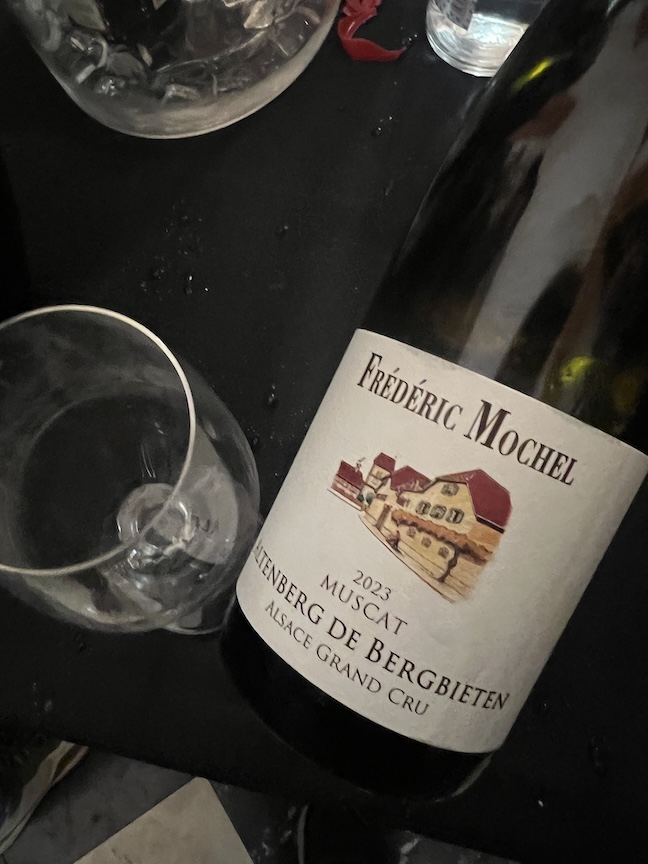
Domaine Paul Ginglinger Pfersigberg Grand Cru Riesling 2019 – Another excellent 2019 Riesling, from vines grown at about 200 meters in altitude, lots of limestone, and the wine feels consequently fresh with some yellow fruit – crunchy apricot – along with subtle wet stone seriousness, expressed in a lively and juicy mid palate leading to a long finish. Coming from another magnum bottle. 96/100

A bit more please : Foulques Aulagnon getting super Riesling from Jeroboam, served by Véronique Muré
Domaine Muré Clos Saint Landelin Grand Cru Vorbourg Riesling 2019 – And the wine that got most of the cherry cakes that evening was this gorgeous Riesling served from one of only four Jeroboam bottles – the equivalent of six standard bottles – produced at the estate, served to diners by co-owner Véronique Muré. Plenty of wet stone with fresh citrus and subtle stone fruit and spring flower. The palate exuded depth and subtle breadth, mid palate sap and a long cool yet rich finish! Located in Rouffach, Clos Saint Landelin, is owned exclusively by the Muré family, covering an area of 12 hectares, forming the southern tip of the Vorbourg grand cru. Located at the end of the valley, it faces south and enjoys excellent sunshine until the end of the day. North and southwesterly winds ensure good health until harvest time. The steep slopes – you get a great view when you visit the estate – require terraced cultivation. The soil is marl-limestone; it is stony; the subsoil is formed of Oligocene conglomerates with oolitic limestone pebbles. All these elements make it a terroir with great character. The vineyard is cultivated using biodynamic agriculture. The vines are planted densely, at around 10,000 vines per hectare. (96/100)
Now, I could not include all tasting notes from this amazing evening but suffice to say: not a single bad wine among the scores of pours. Alsace is making wines better than ever, and you, dear reader, should take time to discover these wines the next time you visit your favorite wine shop. Cheers! 🙂
Château Lafon-Rochet
Posted on October 30, 2025

A New Chapter of Freshness and Finesse
By Panos Kakaviatos for Wine Chronicles
30 October 2025
When Vincent Bache-Gabrielsen (photo above, credit to Château Lafon Rochet) took charge of Château Lafon-Rochet last year, it marked a quiet but meaningful shift for this celebrated classified growth in the Bordeaux appellation of Saint-Estèphe. Having worked within the Lorenzetti family group since 2008 and previously leading Château Pédesclaux in Pauillac, Bache-Gabrielsen essentially swapped posts with Christophe Congé to bring his precision-minded approach to this storied Fourth Growth. His arrival builds on the steady progress made under Basile Tesseron, whose tenure already lifted Lafon-Rochet’s quality to new heights.
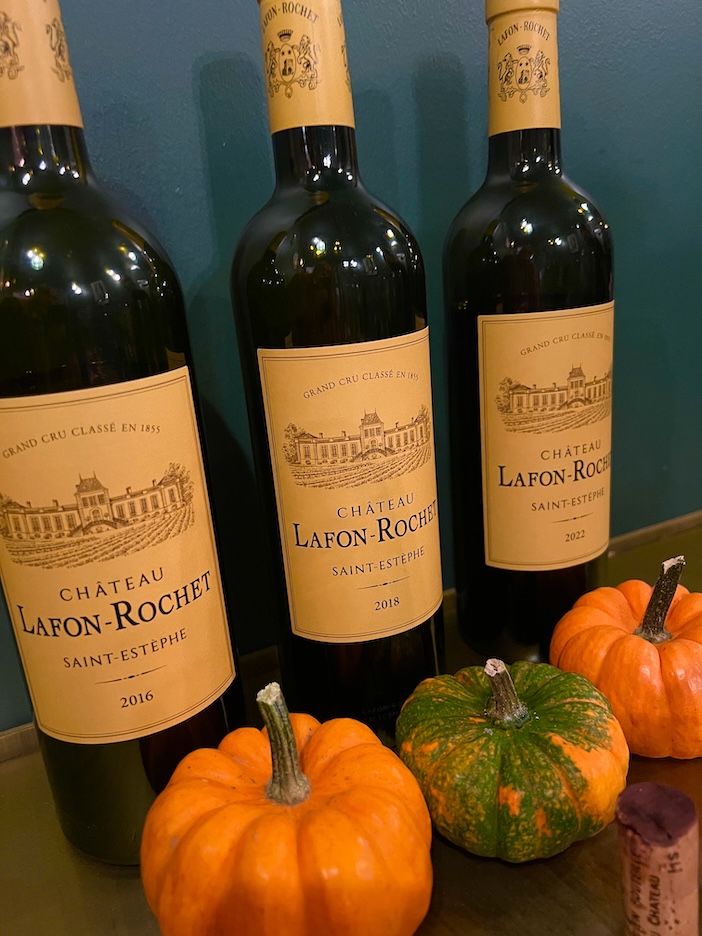
The estate’s core identity remains anchored in its history. Its 1842 vineyard layout is largely intact, although the Tesserons — who took over in the 1960s — expanded the property with several parcels acquired from Château Lafite Rothschild to the west. The Tesseron era also gave Lafon-Rochet its distinctive Tuscan-yellow façade, completed in 2000: a visual statement of renewal and ambition. And it is an appropriate color for Halloween. 🎃👻🦇
Bache-Gabrielsen’s guiding principle can be summed up in two words: puissance and fraicheur — power and lift held in balance. To achieve this, he is fine-tuning viticulture and winemaking. Oak influence is being pared back, from 40 percent new barrels in 2024 to just 15 percent in 2025, while the use of large foudres (large oak vats) will triple to 30 percent. A small proportion of concrete vats — around 10 percent of the élevage — now complements barrel aging, helping to preserve purity of fruit and vibrant energy. The goal is a reach more restrained, terroir-driven expression, with alcohol levels dialed back toward 13 percent and greater emphasis on Cabernet Sauvignon grown on the estate’s cooler gravel and clay soils, while Merlot increasingly occupies fresher plots.

The Boissenot consultancy, a historic partner of the château, returned in 2021 under Éric Boissenot, following the departure of Jean-Claude Berrouet, who had done excellent work for the estate. Together with Bache-Gabrielsen, they are steering Lafon-Rochet toward even finer tannins, more measured extraction, and greater precision. Amphora trials have been set aside in favor of the more reliable and expressive foudres (larger oak casks). The result is a series of wines that combine structure with grace: the 2016 (the first vintage from the new cellars) shows nuance if a touch of youthful austerity; 2018 and 2022 display polish and early charm; and 2023, the first full vintage under Bache-Gabrielsen’s vision, reveals even greater balance and finesse. I feel that the high alcohol in both the 2018 and 2022 vintages can be felt, although not as readily in the 2022, while the 2016 and 2023 vintages seem more balanced. The 2018 and 2022 vintages, which reflect hotter and drier years associated with climate change, may well become more common, thus making the aforementioned goals all the more important.
Tasting notes: 2022, 2018 and 2016

Double decanting for aeration
Initially, I tasted with Bache-Gabrielsen, who was online while I double decanted the wines. I later tasted the wines again that evening with experienced sommelier Ilona Garnier of the popular Strasbourg bistro Pompette. The 2016, the first vintage with new cellars, exudes a palate of freshness and bright fruit, chiseled and smooth tannins, leading to a long finish. This blend of 67% Cabernet Sauvignon, 25% Merlot, 6% Cabernet Franc and 2% Petit Verdot has the lowest pH of the three vintages assessed, at 3.55 (higher acidity), and the lowest alcohol, at 14%. The harvest stretched from 29 September to 20 October.
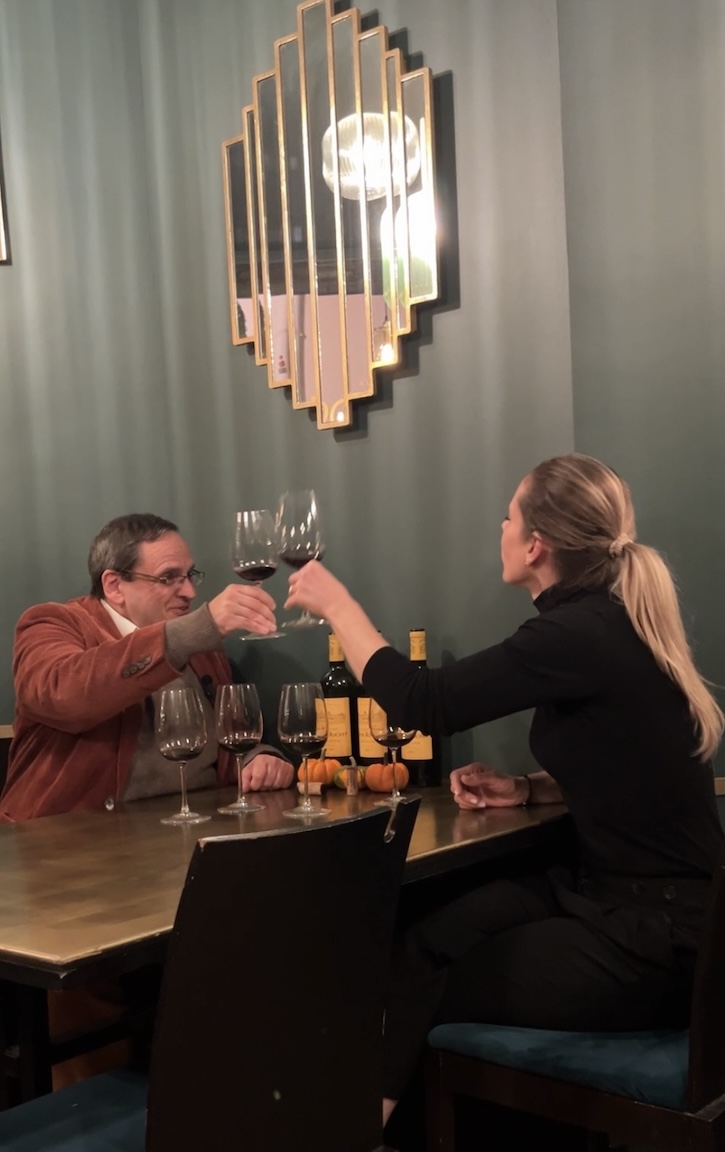
Tasting at Pompette with Ilona Garnier
The 2018, at least at this stage in time, proved the weakest. Garnier and I agreed that it came across somewhat heavy handed, reflecting the dry heat of 2018: a style of vintage that will perform better with less new oak, as planned for the future. A slightly earlier harvest – September 24th to October 13th – reflected hotter, dryer weather compared to the 2016. The blend of 64% Cabernet Sauvignon 26% Merlot 6% Petit Verdot and 4% Cabernet Franc has a higher pH at 3.75 and clocks in at 14.5% alcohol.
The 2022 seemed the most exciting of the three, at least the attack, already looking bright violent, the wine exhibits youthful fresh notes, bursting with black berry and plum fruit. But both Garnier and I still preferred the 2016 overall for more evident freshness and balance, exhibiting the less extreme nature of the year as opposed to all the dry heat of 2018 and 2022. Of course being in bottle about nine years gives 2016 some complexity lacking in the more recent vintages. Still, the 2022 outshines the 2018, as it benefited from softer extractions and more precise winemaking. Certainly reflecting the heat of the vintage, the harvest was done much earlier than in 2016, from 12 to 27 September. The blend of 65% Cabernet Sauvignon, 31% Merlot and 4% Cabernet Franc has a pH of 3.77 and clocks in at 14.5% alcohol.
Lafon-Rochet, long admired for its reliability, is entering a new era defined by clarity, freshness, and classic Saint-Estèphe poise — a rebirth grounded in precision rather than power. Readers should take note that the wines here constitute bargains: while a highly rated wines, prices remain modest: between $50 to $60 retail per bottle.
The Long Game of Greatness: Mouton Rothschild 1986
Posted on October 17, 2025

By Panos Kakaviatos for Wine Chronicles
Main photo: Chateau-Mouton-Rothschild-Cuvier-nuit-©-Pierre-Grenet-Astoria-studio.jpg
17 October 2025
“I bought this wine upon release,” a dear friend told me, speaking about Château Mouton Rothschild 1986. “When I tried one of my bottles three years ago, it still hadn’t opened up”, he said in September 2025, nearly 40 years later.
World famous wine critic Robert Parker gave this wine from Bordeaux’s Left Bank Pauillac appellation a perfect 100 points early in its life: the same perfect score that he had given to the even more famous 1982 vintage. While the 1982 has proven more sensual and approachable, the 1986 remains indeed rather closed. But what makes the 1986 special? Why is it a legend in the making? To answer this question, let’s first examine the 1986 vintage, in general.
The 1986 growing season began slowly with a cool, damp spring, but fine weather in late spring and early summer allowed the vines to catch up. Flowering took place under ideal conditions. The summer that followed was hot, sunny, and dry, leading to drought stress. Indeed, by early September, many vines had shut down, their grapes struggling to ripen. Thanks to mid-September rains, the vines were able to “restart”. But the downpours had a negative effect for earlier-ripening Merlots, causing dilution as their thinner skins absorbed excess water. For estates that harvested too soon, Merlot-based wines often lacked concentration.
By contrast, growers on the Cabernet Sauvignon-dominated Left Bank (including venerable appellations Pauillac, Saint Estèphe, Saint Julien and Margaux) who waited benefited enormously: three weeks of hot, dry, and windy weather in late September and early October followed the rains, which allowed Cabernet Sauvignon to reach full maturity. Those with patience made structured and age-worthy wines — confirming 1986 as a great Cabernet vintage. So it comes as no suprise that the harvest at Mouton took place at such an appropriately later time, from 2-15 October.
How does Mouton 1986 taste today?
The wine itself blends 80% Cabernet Sauvignon, 10% Merlot, 8% Cabernet Franc and 2% Petit Verdot. A little more open than the firmly closed Château Léoville Las Cases 1986, which I tasted not too long ago, the Mouton Rothschild, tasted earlier this month, exuded initial aromas of intense graphite and pencil lead. It had been opened four hours before but – like Las Cases – proved reserved on the palate, with alcohol at 12.5. Time in glass revealed subtle intensity with fresh fruit and spice underneath, burgeoning freshness and brightness. And what tannic finesse! It was not as tightly wound after over one hour of sipping, but remained very youthful. Then came some fresh meadow and cut herb aspects.

Legend in the making
Château Mouton Rothschild 1986 is truly palate enveloping, or even permeating. It then leaves a long, impressive finish. A wine of power and finesse. More cool blue than ripe black fruit, even though the wine has darker fruit. At nearly 40 years of age, it can be enjoyed in 2025, but needs time and air. I would advise another five to 10 years cellaring to loosen up more, and to acquire more tertiary aspects. Still, what an amazing treat! (99 points)
About the Château
The estate itself, though not originally included in the now famous 1855 classification of wines of the Médoc and Sauternes, was promoted from second to first growth after successful lobbying by then owner Baron Philippe de Rothschild (1902-1988), who had taken a series of long, careful steps to prove the wine worthy of such a promotion. In 1924, he decided that all wines should be bottled at the château, which at that time was not common practice. That decision meant more storage space – and more control over wine quality. The 100-meter long cellar space proved to be remarkably aesthetic, reflecting attention to detail and to beauty. Each year, from 1945, the label of each vintage was illustrated with the reproduction of an original artwork specially created for the wine by a contemporary artist, another practice that sets this wine apart. In 1962, the château itself was transformed into one of Bordeaux’s leading tourist attractions with the inauguration of its Museum of Fine Art, always worth a visit.
Beyond aesthetics, the estate proved in many years how it could compete with illustrious first growth Pauillac neighbors Latour and Lafite. Promotion from second to first growth (a rare change in the otherwise immutable ranking) finally came in 1973, when then French Agriculture Minister Jacques Chirac signed a decree making it so.
The 1986 vintage label boasts an intriguing trio of masks by Bernard Séjourné (1947-1994). The artist was born in Haiti where his family were planters. The white masks on a black background convey mystery and sophistication, interestingly reflecting the style of the wine. You can see all other Mouton labels since 1945, famous for the V for victory, here.
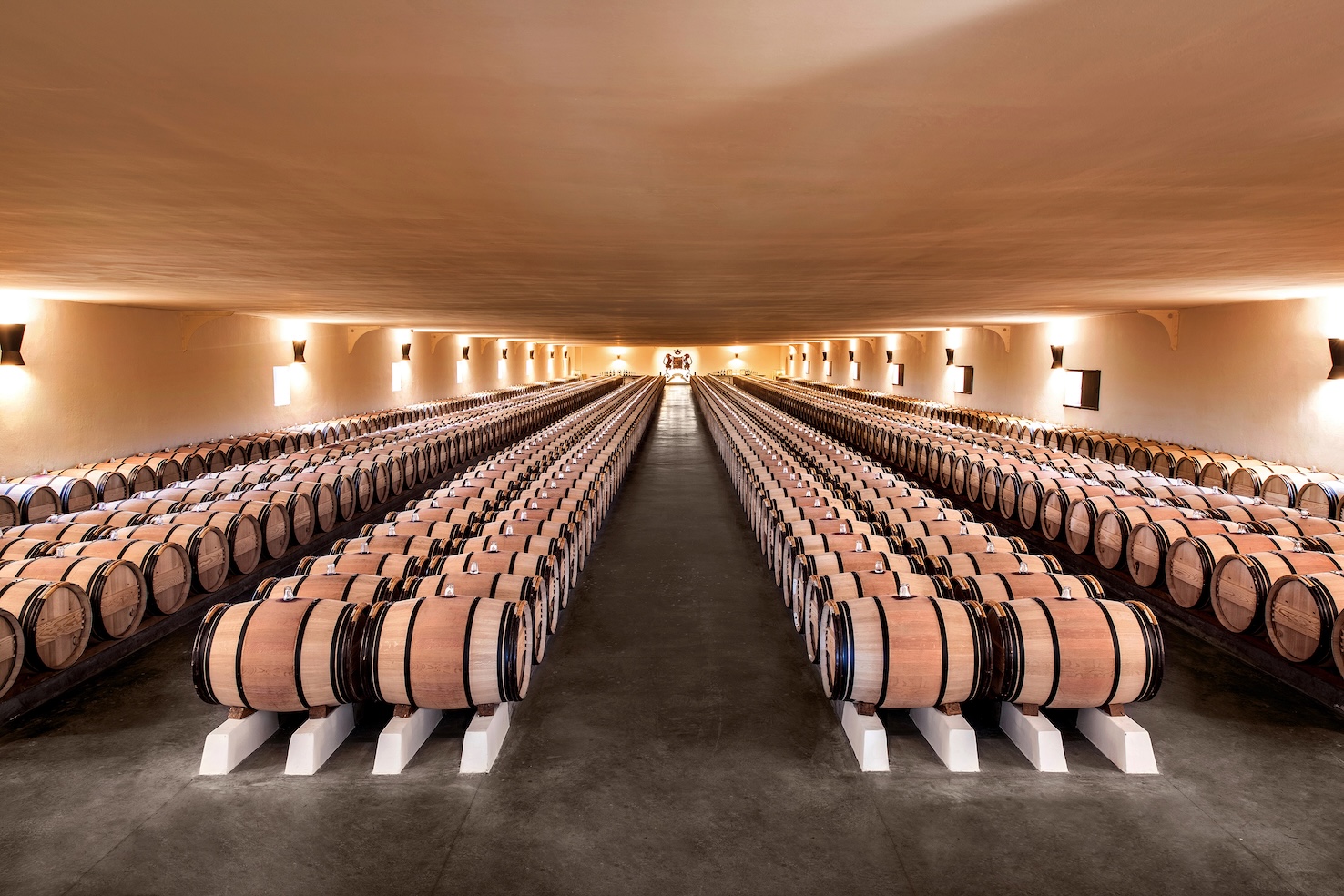
Barrel aging at Château Mouton Rothschild, photo copyright Alain Benoit
Nearly four decades on, the 1986 Mouton Rothschild remains a monument to patience — a wine that reveals itself more in whispers than proclamations. Born of a vintage that rewarded patience, it continues to evolve with slow majesty — firm, fresh, and remarkably youthful. Today, its brilliance lies not in opulence (like the 1982) but in precision — graphite, herb, and cool blue fruit etched against a backbone of iron. Like the château’s own journey from second to first growth, its greatness was never instant but earned through time, discipline, and vision. In a social media driven world, where immediacy is prized, the 1986 reminds us that true greatness often takes its time: It is a legend in the making.
A Star, a Steal… and a Splurge: Lunch with Clos Sainte Hune
Posted on October 16, 2025
Because sometimes “economical” ends at the wine list
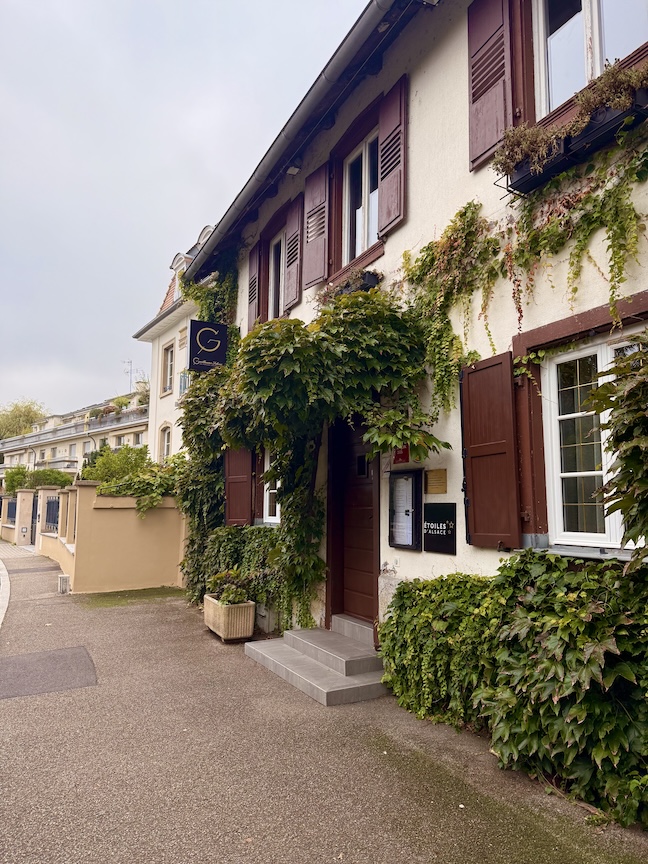
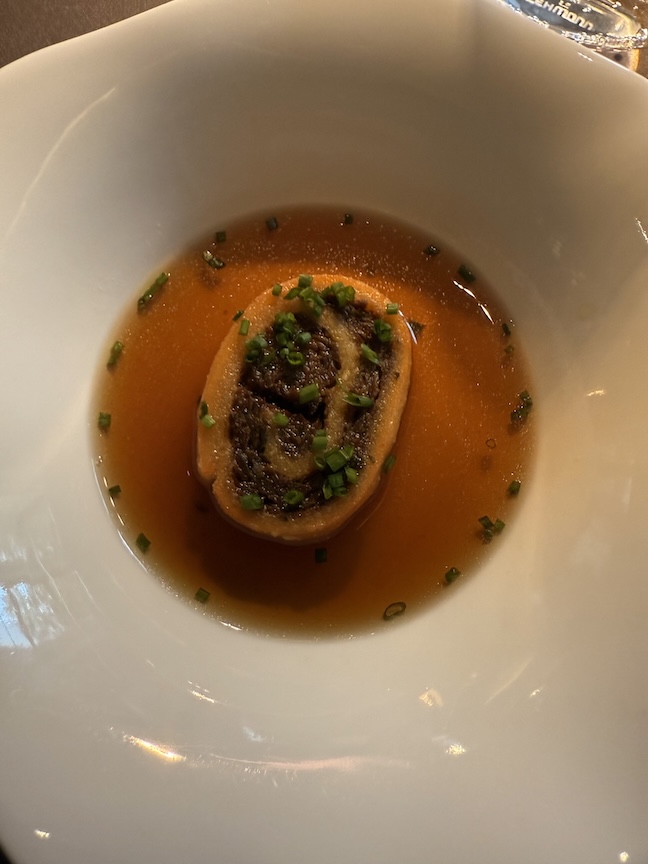
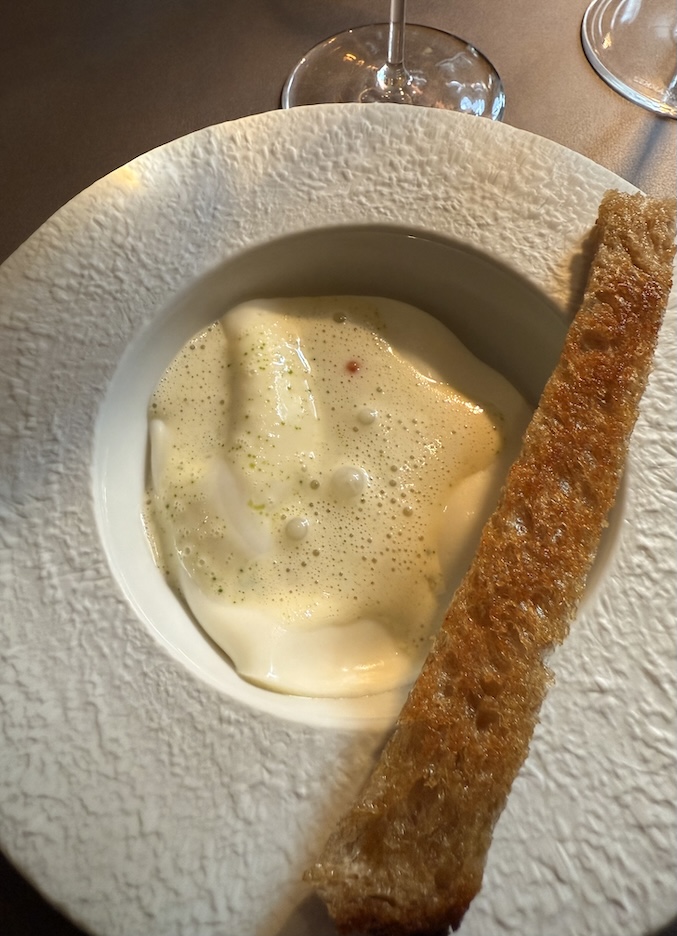
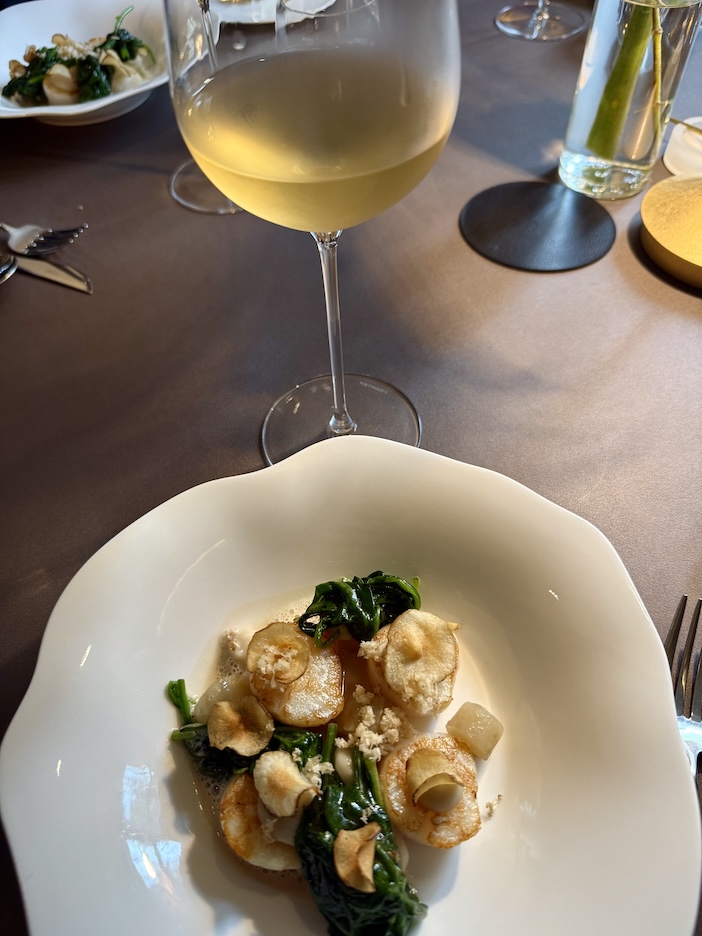
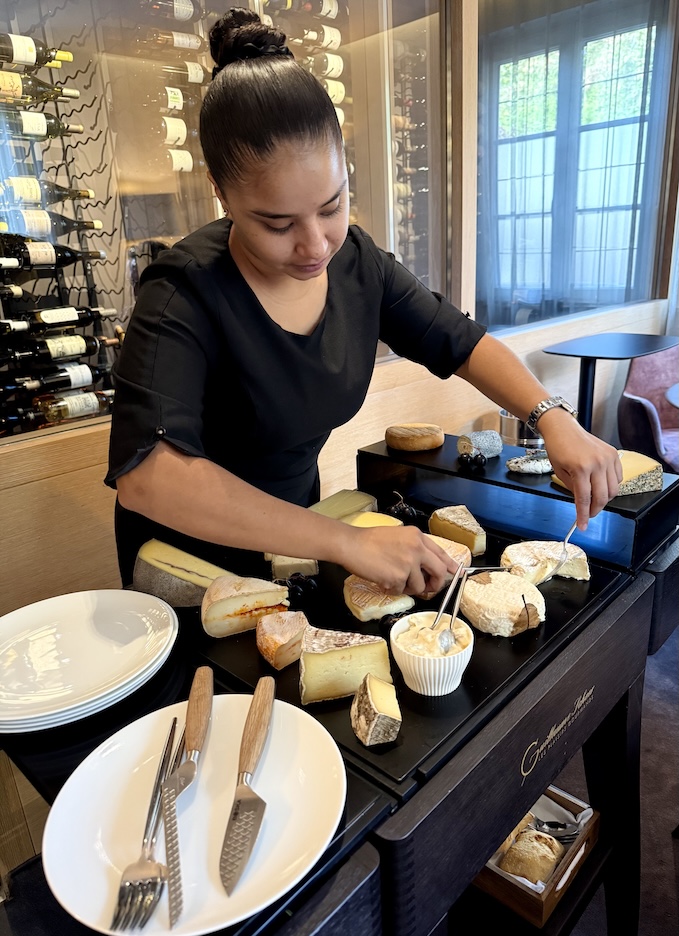
A wide variety of cheeses : €15 extra

Although far too young at but eight years since the harvest, time in glass revealed the greatness of Clos Sainte Hune.

Don, Pam, myself and Jürgen
Médoc Blanc officially born
Posted on October 14, 2025

The red stronghold has a white awakening — Bordeaux’s Médoc embraces a lighter side.
By Panos Kakaviatos for Wine Chronicles
14 October 2025
Last year, I wrote in Decanter of prospects for an official Médoc Blanc appellation. That consideration is now reality.
Starting with the 2025 vintage, winegrowers from all eight Médoc AOCs, including Margaux, Pauillac, Saint-Estèphe and Saint Julien, will be able to jointly produce wine under the Médoc Blanc moniker: “A small revolution”, according to a press release issued today by the Médoc, Haut-Médoc and Listrac-Médoc Wine Council, for an appellation previously reserved for red wines since its creation in 1936. Until this year, then, all white Médoc wines are identified as basic Bordeaux appellation wines.
Desired by an increasing number of winegrowers at châteaux across the Médoc, the Médoc Blanc appellation is both “recognition of a little-known tradition and a distinctive product, providing a strong guarantee of quality and authenticity,” so goes the press release.
The lofty words match some reality. Tasting Médoc’s whites can reveal stylistic and price diversity, as producers respond to rising consumer demand for lighter wines. Take for example merchants and enologists in Strasbourg, France. They professed elation over the “surprising freshness” of many white wines from the Médoc. “I was expecting oaky wines, coming from Bordeaux,” said Sylvain Girard who had hosted a tasting at his Strasbourg wine boutique Cave à Terroirs. Like so many autumn mushrooms, white wines have been popping up at rapid rate in the Médoc, and they are not oaky, but often fresh and zingy.
For Claude Gaudin, president of the Médoc, Haut-Médoc and Listrac-Médoc Wine Council, the official recognition of the region’s white wines is “not only a testament to the work of several generations of winemakers from across the Médoc peninsula, but also a burst of optimism for the future.” Referring to market interest for white, he adds that the white wines of the Médoc constitute a “new gateway to discovering (or rediscovering) the magnificent and wide range of our red wines.”
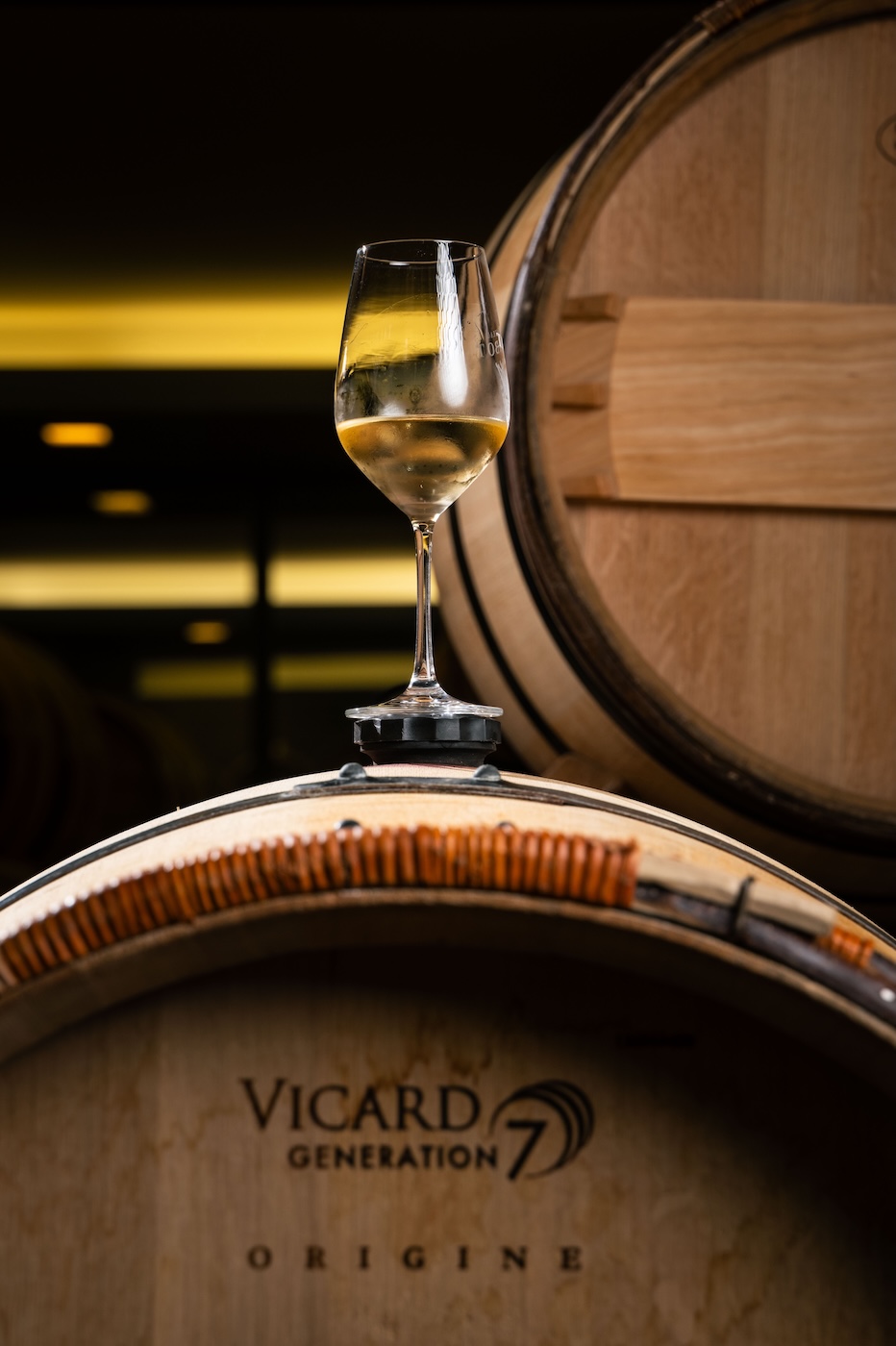
One of my favorite white wines from the Médoc, the Caillou Blanc of Château Talbot, in Saint-Julien (photo courtesy of Château Talbot)
Why Médoc Blanc?
The most well-known Bordeaux whites come from the classified Graves region – specifically from the 1987-created appellation Pessac-Léognan within Graves. Which avid Bordeaux wine drinker does not get excited when hearing the name Haut Brion, for white as well as red? Given the prominence of Pessac-Léognan, industry observers have been dubious about Médoc Blanc.
“A well-behaved Médoc must always be red,” Washington D.C.-based wine educator and former Washington Post wine columnist Ben Giliberti had told me. “Not a single white wine was included in the 1855 classification of the Médoc, and over the centuries, the word claret has become synonymous with Médoc: well-balanced, well structured, and red,” he explained. “For as long as Graves continues to exist, white Médocs are the answer to a question that nobody asked.”
But backers of Médoc Blanc point to a longer-than-expected history of white production there, reaching back to the 18th century. First Growth Château Margaux was making white wine in that century, says director Philippe Bascaules, even if the famous Blanc Pavillon Blanc brand was established in 1920. Château Loudenne, in Saint-Yzans-de-Médoc, bills itself as the oldest consecutive producer of dry whites, with annual production starting in 1880.
That history, once nearly forgotten, is now being written anew. Today, white Médoc has made a confident return, and when I attend tastings in the region, I increasingly look forward to discovering estate whites — many of them remarkably good, from Talbot and Lagrange to Cos d’Estournel and Le Merle Blanc of Château Clarke, a favorite of mine for its excellent price-to-quality ratio.
So, cheers to Médoc Blanc — proof that even in Bordeaux’s reddest heart, there’s room for a white wine magic. 🥂✨
 Wine Chronicles
Wine Chronicles
Recent Comments